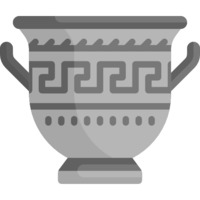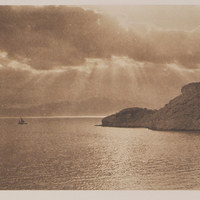Υρτάκινα
Αντικείμενο
Τίτλος Σημείου Ενδιαφέροντος
el
Υρτάκινα
en
Hyrtakina
Περιγραφή / Απόσπασμα
147-150
en
After following their course on the south western side for about two hundred paces, we arrive at an entrance not only defended by the ordinary projections of the outer wall, but by what is here observed within, two other walls extending for some distance nearlyparalleltotheouterone. Thedistancebetween the outer and the second wall is about ten paces ; that between the second and third near forty. Soon after passing this entrance, we find a considerable piece of the outer wall, which is still from five to twelve or thirteen feet high. The piece sketched1 is perhaps rather more regular, in the size and forms of the stones, than the greater part of the walls which remain ; but the whole may be considered as a near approach to what has been termed the second style of cyclopian masonry.
Σύγχρονη περιγραφή
el
Η Υρτακίνα υπήρξε μία από τις σπουδαιότερες αρχαίες πόλεις της ορεινής ενδοχώρας στη νοτιοδυτική Κρήτη και ήταν κτισμένη στον απόκρημνο λόφο Καστρί, κοντά στο χωριόΤεμένια Σελίνου. Η ονομασία Υρτακίνα μπορεί να συνδέεται είτε με το όνομα Ύρτακος, που αναφέρεται στον Όμηρο, ως ένας άνδρας από την Τροία, είτε με τη λέξη υρτακός, που σημαίνει το όστρεο, δηλαδή το στρείδι.
Η αρχική εγκατάσταση στην περιτειχισμένη ακρόπολη έγινε στην Πρώιμη εποχή του Σιδήρου ωστόσο, η ακμή της προσδιορίζεται στους ελληνιστικούς χρόνους, όταν η πόλη έκοψε το δικό της νόμισμα με απεικόνιση κεφαλής αιγάγρου στη μπροστινή πλευρά και μέλισσας στην πίσω πλευρά. Στις αρχές του 3ου αιώνα π.Χ., η πόλη μετείχε στην «Ομοσπονδία ή Κοινό των Ορείων» με έδρα τη Λισό, που λειτουργούσε ως επίνειό της. Μάλιστα, η Υρτακίνα μέσω της Λισού εξασφάλιζε τη θαλάσσια επικοινωνία της με τις πόλεις της Βόρειας Αφρικής και με τη νότια Ιταλία. Τμήμα του αρχαίου δρόμου που συνέδεε την πόλη με τη Λισό έχει εντοπιστεί στη δυτική είσοδό της και σε αρκετά άλλα τμήματα της περιοχής. Κατά τους ρωμαϊκούς χρόνους η πόλη πέρασε μία περίοδο παρακμής και εγκαταλείφθηκε. Σήμερα, στην Υρτακίνα σώζονται τα ερείπια διπλού οχυρωματικού τείχους, που σε ορισμένα τμήματα διατηρείται σε πολύ καλή κατάσταση, ενώ σε άλλα συμπληρώνεται από τους απότομους βράχους. Εντός των τειχών, διακρίνονται κατόψεις κτηρίων που το μέγεθος και ο τρόπος κατασκευής τους δείχνουν ότι πρόκειται για δημόσια κτήρια Στην περιοχή ανασκάφηκε και ένα υπαίθριο ιερό, αφιερωμένο στο θεό Πάνα, από όπου συγκεντρώθηκαν ένα μαρμάρινο λατρευτικό γλυπτό, ορισμένα τμήματα μίας αναθηματικής επιγραφής και πολλά πήλινα αναθηματικά ειδώλια. Τέλος, εκτός των τειχών, εκτείνεται το νεκροταφείο της πόλης με λαξευτούς τάφους.
Η αρχική εγκατάσταση στην περιτειχισμένη ακρόπολη έγινε στην Πρώιμη εποχή του Σιδήρου ωστόσο, η ακμή της προσδιορίζεται στους ελληνιστικούς χρόνους, όταν η πόλη έκοψε το δικό της νόμισμα με απεικόνιση κεφαλής αιγάγρου στη μπροστινή πλευρά και μέλισσας στην πίσω πλευρά. Στις αρχές του 3ου αιώνα π.Χ., η πόλη μετείχε στην «Ομοσπονδία ή Κοινό των Ορείων» με έδρα τη Λισό, που λειτουργούσε ως επίνειό της. Μάλιστα, η Υρτακίνα μέσω της Λισού εξασφάλιζε τη θαλάσσια επικοινωνία της με τις πόλεις της Βόρειας Αφρικής και με τη νότια Ιταλία. Τμήμα του αρχαίου δρόμου που συνέδεε την πόλη με τη Λισό έχει εντοπιστεί στη δυτική είσοδό της και σε αρκετά άλλα τμήματα της περιοχής. Κατά τους ρωμαϊκούς χρόνους η πόλη πέρασε μία περίοδο παρακμής και εγκαταλείφθηκε. Σήμερα, στην Υρτακίνα σώζονται τα ερείπια διπλού οχυρωματικού τείχους, που σε ορισμένα τμήματα διατηρείται σε πολύ καλή κατάσταση, ενώ σε άλλα συμπληρώνεται από τους απότομους βράχους. Εντός των τειχών, διακρίνονται κατόψεις κτηρίων που το μέγεθος και ο τρόπος κατασκευής τους δείχνουν ότι πρόκειται για δημόσια κτήρια Στην περιοχή ανασκάφηκε και ένα υπαίθριο ιερό, αφιερωμένο στο θεό Πάνα, από όπου συγκεντρώθηκαν ένα μαρμάρινο λατρευτικό γλυπτό, ορισμένα τμήματα μίας αναθηματικής επιγραφής και πολλά πήλινα αναθηματικά ειδώλια. Τέλος, εκτός των τειχών, εκτείνεται το νεκροταφείο της πόλης με λαξευτούς τάφους.
en
Yrtakina was one of the most important ancient cities of the mountainous mainland at southwestern Crete and was built on the secluded hill of Kastri, near the village Temenia of Selino. The name Yrtakina may be connected either to the name Yrtakos, which is mentioned in Homer, as a man from Troy, either to the word yrtakos which means oyster.
The initial installation at the walled acropolis took place during the early Iron era, however, its acme is determined to be in the Hellenistic times, when the city minted its own coin depicting the head of a wild goat at the front and a bee at the back. In the beginning of the 3rd century BC, the city participated at the “Confederation or Common of the Oreians” with Lissos as its headquarters, which functioned as its seaharbour. In fact, Yrtakina, through Lissos, secured its sea communication with the cities of the Northern Africa and with southern Italy. A part of the ancient road that connected the city to Lissos has been located at its western entrance and several other parts of the area. During Roman times, the city went through a period of decline and was then abandoned. Today in Yrtakina, the ruins of a double fortified wall are preserved, which are in some parts in a very good condition, while other parts are supplemented by steep rocks. Within the walls, there are facades of buildings, of which the size and manner of construction show that they are public buildings. In the area there was also an open-air sanctuary, dedicated to god Pan, from where came from a marble worshiping sculpture, some parts of a votive inscription and many clay votive figurines. Finally, within the walls, the graveyard of the city is extended, with carved tombstones.
The initial installation at the walled acropolis took place during the early Iron era, however, its acme is determined to be in the Hellenistic times, when the city minted its own coin depicting the head of a wild goat at the front and a bee at the back. In the beginning of the 3rd century BC, the city participated at the “Confederation or Common of the Oreians” with Lissos as its headquarters, which functioned as its seaharbour. In fact, Yrtakina, through Lissos, secured its sea communication with the cities of the Northern Africa and with southern Italy. A part of the ancient road that connected the city to Lissos has been located at its western entrance and several other parts of the area. During Roman times, the city went through a period of decline and was then abandoned. Today in Yrtakina, the ruins of a double fortified wall are preserved, which are in some parts in a very good condition, while other parts are supplemented by steep rocks. Within the walls, there are facades of buildings, of which the size and manner of construction show that they are public buildings. In the area there was also an open-air sanctuary, dedicated to god Pan, from where came from a marble worshiping sculpture, some parts of a votive inscription and many clay votive figurines. Finally, within the walls, the graveyard of the city is extended, with carved tombstones.





